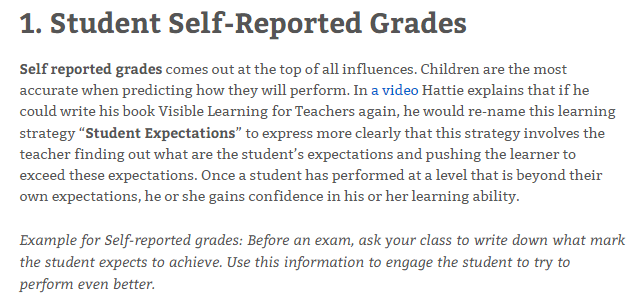Very early on, in headship, I developed a series of three touchstones that proved useful when faced with complex decisions. Was the decision I was taking legal and moral? Would it keep the wolves away from the door (read Ofsted)? And would it, when implemented, be good enough for my children?
The start of a new year (academic, financial, ecclesiastical or calendar) is a great time to reset your thinking and make sure you are focused on the right things. One possibility is suggesting that more grammar schools will improve standards and social equity; alternatively you can put your efforts into improving teaching and learning. My advice is get your teaching touchstones or personal mantras in good order; to remind you what’s important, what really matters to your pupils, what will make a difference. It won’t cost you £50 million and there can be some evidence to support your decision making.
In response to a tweet about the potential efficacy of learning intentions and success criteria I referenced them to John Hattie’s glossary on influences related to pupil achievement. In a moment of twitter diversion therapy I sent out a tweet; be challenging, credible and clear. It’s a possible touchstone or mantra for the term ahead. Its genesis is explained below.
Be Challenging

Acknowledgement: John Hattie’s glossary on influences related to pupil achievement
Top of Hattie’s list of influences on pupils’ achievement is self-reported grades. Pupils may have a very good idea of how they will perform; this can also become a limiter for many pupils. They will attain that and no more. Be challenging is the reminder to work with pupils and reinforce your belief that over achievement is allowed in your classroom. Re-frame their aspiration for them by continually pushing them one step beyond what they have currently achieved. Taking an Olympic perspective; require them to keep improving their personal best.
Be Credible

Acknowledgement: John Hattie’s glossary on influences related to pupil achievement
Fourth on the list and a new one to me was Teacher Credibility. You inherit a reputation over time, for better or worse. It’s one of those moments where you might want to change the past; accept you can’t and focus on the pupils, classes and year ahead. If the pupils know they are important to you – by the way you prepare lessons, teach and relate to them in class, assess their work, have high expectations of them and pick them up when they fall down – then you will be important to them. You don’t have to get everything right; they’re not looking for perfection. The best version of you is likely to be just fine.
Be Clear

Acknowledgement: John Hattie’s glossary on influences related to pupil achievement
This was actually where I started. Define excellence in concrete terms for pupils; they now know where they are heading. Think through the learning progression; what you will teach in what order to aid pupils understanding. Make sure you regularly find out “what they don’t know or can’t do”. Fill in these gaps in learning at the start, throughout and at the end of the topic.
If be challenging, credible and clear doesn’t work for you, what about:
Pupils in my class must work harder than me
This is a great one to keep you on the straight and narrow with respect to marking and in particularly formative assessment. It’s what the pupil’s do with your feedback that really makes the difference.
View teaching through the lens of pupils learning
This incorporates the important influences of microteaching and feedback to the teacher, particularly using data on how pupils performed in an assessment. There’s a reasonable link between pupils’ performance in an assessment and your teaching. This keystone or mantra helps keep you focused on your impact.
Feel free to share with me your touchstones or mantras for the year ahead. The headship one, “Would this be good enough for my children” works equally well in the classroom.




Discussion
No comments yet.